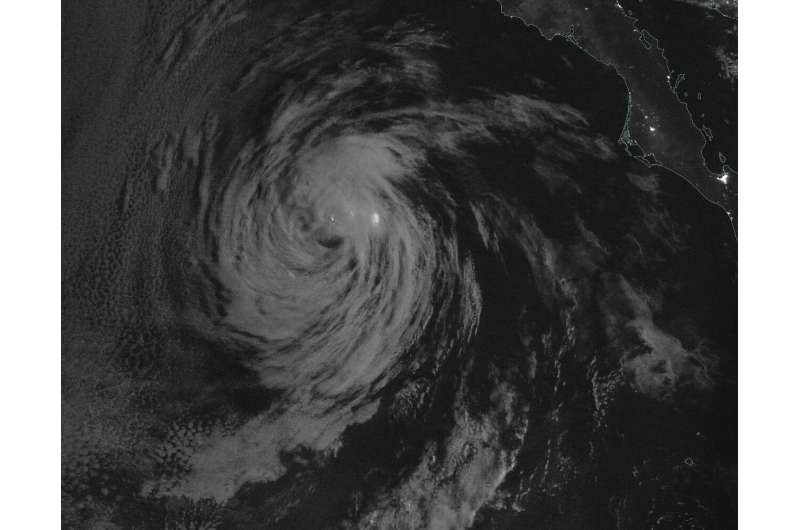NASA-NOAA satellite nighttime imagery helps confirm Elida now post-tropical

NASA-NOAA's Suomi NPP satellite provided a night-time image of Elida in the Eastern Pacific Ocean that helped confirm the storm had weakened to a post-tropical cyclone.
What is a Post-tropical Cyclone?
The National Hurricane Center (NHC) defines a post-tropical cyclone as a former tropical cyclone. This generic term describes a cyclone that no longer possesses sufficient tropical characteristics to be considered a tropical cyclone. Post-tropical cyclones can continue carrying heavy rains and high winds. Note that former tropical cyclones that have become fully extratropical... as well as remnant low pressure areas... are two classes of post-tropical cyclones.
NASA's Night-Time View of Elida's Transition
The Visible Infrared Imaging Radiometer Suite (VIIRS) instrument aboard Suomi NPP provided a night-time image of Elida on Aug. 12 at 10 p.m. PDT (Aug. 13 at 0500 UTC). The imagery showed that Elida was still devoid of strong thunderstorms. The image was created using the NASA Worldview application.
Two hours earlier, NOAA's National Hurricane Center (NHC) noted, "Elida has been devoid of deep convection for more than 12 hours, and since it is over sea surface temperatures of 22 to 23 degrees Celsius (71.6 to 73.4 degrees Fahrenheit), it is unlikely that organized deep convection will return. As a result, the system has become a post-tropical cyclone, and this will be the last NHC advisory on Elida."
Tropical cyclones require warm sea surface temperatures of at least 26.6 degrees Celsius (80 degrees Fahrenheit) to maintain strength and continue building the thunderstorms that make up a tropical cyclone.
Elida's Last Advisory
At 11 p.m. EDT on Aug. 12 (0300 UTC on Aug. 13), the National Hurricane Center (NHC) issued the final advisory on Elida. At that time, it was located near latitude 24.4 degrees north and longitude 120.2 degrees west. That is about 395 miles (635 km) southwest of Punta Eugenia, Mexico.
The post-tropical cyclone is moving toward the northwest near 9 mph (15 kph). A northwestward or north-northwestward motion at a slower forward speed is expected through Thursday. Maximum sustained winds have decreased to near 40 mph (65 kph) with higher gusts. The estimated minimum central pressure is 1004 millibars.
Additional weakening is expected during the next day or so, and the remnant low is forecast to dissipate early Friday.
About NASA's EOSDIS Worldview
NASA's Earth Observing System Data and Information System (EOSDIS) Worldview application provides the capability to interactively browse over 700 global, full-resolution satellite imagery layers and then download the underlying data. Many of the available imagery layers are updated within three hours of observation, essentially showing the entire Earth as it looks "right now."
NASA Researches Earth from Space
For more than five decades, NASA has used the vantage point of space to understand and explore our home planet, improve lives and safeguard our future. NASA brings together technology, science, and unique global Earth observations to provide societal benefits and strengthen our nation. Advancing knowledge of our home planet contributes directly to America's leadership in space and scientific exploration.
Provided by NASA's Goddard Space Flight Center




















